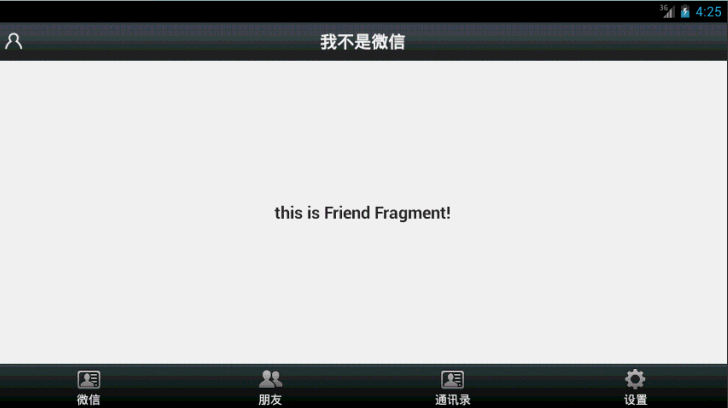本文共 9987 字,大约阅读时间需要 33 分钟。
是在Android 3.0 (API level 11)开始引入Fragment的。
可以把Fragment想成Activity中的模块,这个模块有自己的布局,有自己的生命周期,单独处理自己的输入,在Activity运行的时候可以加载或者移除Fragment模块。
可以把Fragment设计成可以在多个Activity中复用的模块。
当开发的应用程序同时适用于平板电脑和手机时,可以利用Fragment实现灵活的布局,改善用户体验。
如图:

Fragment的生命周期
因为Fragment必须嵌入在Acitivity中使用,所以Fragment的生命周期和它所在的Activity是密切相关的。
如果Activity是暂停状态,其中所有的Fragment都是暂停状态;如果Activity是stopped状态,这个Activity中所有的Fragment都不能被启动;如果Activity被销毁,那么它其中的所有Fragment都会被销毁。
但是,当Activity在活动状态,可以独立控制Fragment的状态,比如加上或者移除Fragment。
当这样进行fragment transaction(转换)的时候,可以把fragment放入Activity的back stack中,这样用户就可以进行返回操作。

可以看到Fragment比Activity多了几个额外的生命周期回调方法:
onAttach(Activity)
当Fragment与Activity发生关联时调用。
onCreateView(LayoutInflater, ViewGroup,Bundle)
创建该Fragment的视图
onActivityCreated(Bundle)
当Activity的onCreate方法返回时调用
onDestoryView()
与onCreateView想对应,当该Fragment的视图被移除时调用
onDetach()
与onAttach相对应,当Fragment与Activity关联被取消时调用
注意:除了onCreateView,其他的所有方法如果你重写了,必须调用父类对于该方法的实现,
3、静态的使用Fragment
嘿嘿,终于到使用的时刻了~~
这是使用Fragment最简单的一种方式,把Fragment当成普通的控件,直接写在Activity的布局文件中。步骤:
1、继承Fragment,重写onCreateView决定Fragemnt的布局
2、在Activity中声明此Fragment,就当和普通的View一样
下面展示一个例子(我使用2个Fragment作为Activity的布局,一个Fragment用于标题布局,一个Fragment用于内容布局):
TitleFragment的布局文件:
- <?xml version="1.0" encoding="utf-8"?>
- <RelativeLayout xmlns:android="http://schemas.android.com/apk/res/android"
- android:layout_width="match_parent"
- android:layout_height="45dp"
- android:background="@drawable/title_bar" >
- <ImageButton
- android:id="@+id/id_title_left_btn"
- android:layout_width="wrap_content"
- android:layout_height="wrap_content"
- android:layout_centerVertical="true"
- android:layout_marginLeft="3dp"
- android:background="@drawable/showleft_selector" />
- <TextView
- android:layout_width="fill_parent"
- android:layout_height="fill_parent"
- android:gravity="center"
- android:text="我不是微信"
- android:textColor="#fff"
- android:textSize="20sp"
- android:textStyle="bold" />
- </RelativeLayout>
TitleFragment
- package com.zhy.zhy_fragments;
- import android.app.Fragment;
- import android.os.Bundle;
- import android.view.LayoutInflater;
- import android.view.View;
- import android.view.View.OnClickListener;
- import android.view.ViewGroup;
- import android.widget.ImageButton;
- import android.widget.Toast;
- public class TitleFragment extends Fragment
- {
- private ImageButton mLeftMenu;
- @Override
- public View onCreateView(LayoutInflater inflater, ViewGroup container,
- Bundle savedInstanceState)
- {
- View view = inflater.inflate(R.layout.fragment_title, container, false);
- mLeftMenu = (ImageButton) view.findViewById(R.id.id_title_left_btn);
- mLeftMenu.setOnClickListener(new OnClickListener()
- {
- @Override
- public void onClick(View v)
- {
- Toast.makeText(getActivity(),
- "i am an ImageButton in TitleFragment ! ",
- Toast.LENGTH_SHORT).show();
- }
- });
- return view;
- }
- }
同理还有ContentFragment的其布局文件:
- <?xml version="1.0" encoding="utf-8"?>
- <LinearLayout xmlns:android="http://schemas.android.com/apk/res/android"
- android:layout_width="match_parent"
- android:layout_height="match_parent"
- android:orientation="vertical" >
- <TextView
- android:layout_width="fill_parent"
- android:layout_height="fill_parent"
- android:gravity="center"
- android:text="使用Fragment做主面板"
- android:textSize="20sp"
- android:textStyle="bold" />
- </LinearLayout>
- package com.zhy.zhy_fragments;
- import android.app.Fragment;
- import android.os.Bundle;
- import android.view.LayoutInflater;
- import android.view.View;
- import android.view.ViewGroup;
- public class ContentFragment extends Fragment
- {
- @Override
- public View onCreateView(LayoutInflater inflater, ViewGroup container,
- Bundle savedInstanceState)
- {
- return inflater.inflate(R.layout.fragment_content, container, false);
- }
- }
MainActivity
- package com.zhy.zhy_fragments;
- import android.app.Activity;
- import android.os.Bundle;
- import android.view.Window;
- public class MainActivity extends Activity
- {
- @Override
- protected void onCreate(Bundle savedInstanceState)
- {
- super.onCreate(savedInstanceState);
- requestWindowFeature(Window.FEATURE_NO_TITLE);
- setContentView(R.layout.activity_main);
- }
- }
Activity的布局文件:
- <RelativeLayout xmlns:android="http://schemas.android.com/apk/res/android"
- xmlns:tools="http://schemas.android.com/tools"
- android:layout_width="match_parent"
- android:layout_height="match_parent" >
- <fragment
- android:id="@+id/id_fragment_title"
- android:name="com.zhy.zhy_fragments.TitleFragment"
- android:layout_width="fill_parent"
- android:layout_height="45dp" />
- <fragment
- android:layout_below="@id/id_fragment_title"
- android:id="@+id/id_fragment_content"
- android:name="com.zhy.zhy_fragments.ContentFragment"
- android:layout_width="fill_parent"
- android:layout_height="fill_parent" />
- </RelativeLayout>
是不是把Fragment当成普通的View一样声明在Activity的布局文件中,然后所有控件的事件处理等代码都由各自的Fragment去处理,瞬间觉得Activity好干净有木有~~代码的可读性、复用性以及可维护性是不是瞬间提升了~~~下面看下效果图:
4、动态的使用Fragment
上面已经演示了,最简单的使用Fragment的方式~下面介绍如何动态的添加、更新、以及删除Fragment
为了动态使用Fragment,我们修改一下Actvity的布局文件,中间使用一个FrameLayout,下面添加四个按钮~~~嘿嘿~~不是的按钮- -!
- <RelativeLayout xmlns:android="http://schemas.android.com/apk/res/android"
- xmlns:tools="http://schemas.android.com/tools"
- android:layout_width="match_parent"
- android:layout_height="match_parent" >
- <fragment
- android:id="@+id/id_fragment_title"
- android:name="com.zhy.zhy_fragments.TitleFragment"
- android:layout_width="fill_parent"
- android:layout_height="45dp" />
- <include
- android:id="@+id/id_ly_bottombar"
- android:layout_width="fill_parent"
- android:layout_height="55dp"
- android:layout_alignParentBottom="true"
- layout="@layout/bottombar" />
- <FrameLayout
- android:id="@+id/id_content"
- android:layout_width="fill_parent"
- android:layout_height="fill_parent"
- android:layout_above="@id/id_ly_bottombar"
- android:layout_below="@id/id_fragment_title" />
- </RelativeLayout>
底部四个按钮的布局就不贴了,到时看效果图就明白了~~
下面主Activity
- package com.zhy.zhy_fragments;
- import android.app.Activity;
- import android.app.FragmentManager;
- import android.app.FragmentTransaction;
- import android.os.Bundle;
- import android.view.View;
- import android.view.View.OnClickListener;
- import android.view.Window;
- import android.widget.LinearLayout;
- public class MainActivity extends Activity implements OnClickListener
- {
- private LinearLayout mTabWeixin;
- private LinearLayout mTabFriend;
- private ContentFragment mWeixin;
- private FriendFragment mFriend;
- @Override
- protected void onCreate(Bundle savedInstanceState)
- {
- super.onCreate(savedInstanceState);
- requestWindowFeature(Window.FEATURE_NO_TITLE);
- setContentView(R.layout.activity_main);
- // 初始化控件和声明事件
- mTabWeixin = (LinearLayout) findViewById(R.id.tab_bottom_weixin);
- mTabFriend = (LinearLayout) findViewById(R.id.tab_bottom_friend);
- mTabWeixin.setOnClickListener(this);
- mTabFriend.setOnClickListener(this);
- // 设置默认的Fragment
- setDefaultFragment();
- }
- private void setDefaultFragment()
- {
- FragmentManager fm = getFragmentManager();
- FragmentTransaction transaction = fm.beginTransaction();
- mWeixin = new ContentFragment();
- transaction.replace(R.id.id_content, mWeixin);
- transaction.commit();
- }
- @Override
- public void onClick(View v)
- {
- FragmentManager fm = getFragmentManager();
- // 开启Fragment事务
- FragmentTransaction transaction = fm.beginTransaction();
- switch (v.getId())
- {
- case R.id.tab_bottom_weixin:
- if (mWeixin == null)
- {
- mWeixin = new ContentFragment();
- }
- // 使用当前Fragment的布局替代id_content的控件
- transaction.replace(R.id.id_content, mWeixin);
- break;
- case R.id.tab_bottom_friend:
- if (mFriend == null)
- {
- mFriend = new FriendFragment();
- }
- transaction.replace(R.id.id_content, mFriend);
- break;
- }
- // transaction.addToBackStack();
- // 事务提交
- transaction.commit();
- }
- }
可以看到我们使用FragmentManager对Fragment进行了动态的加载,这里使用的是replace方法~~下一节我会详细介绍FragmentManager的常用API。
注:如果使用Android3.0以下的版本,需要引入v4的包,然后Activity继承FragmentActivity,然后通过getSupportFragmentManager获得FragmentManager。不过还是建议版Menifest文件的uses-sdk的minSdkVersion和targetSdkVersion都改为11以上,这样就不必引入v4包了。
代码中间还有两个Fragment的子类,ContentFragment上面已经见过,FriendFragment其实类似:
- package com.zhy.zhy_fragments;
- import android.app.Fragment;
- import android.os.Bundle;
- import android.view.LayoutInflater;
- import android.view.View;
- import android.view.ViewGroup;
- public class FriendFragment extends Fragment
- {
- @Override
- public View onCreateView(LayoutInflater inflater, ViewGroup container,
- Bundle savedInstanceState)
- {
- return inflater.inflate(R.layout.fragment_friend, container, false);
- }
- }
效果图:
可以看到很好的实现了效果,其实这个效果以前的博客中也出现过,在博客:,有兴趣可以看看。ps:为了代码的简洁,就不添加按钮的点击变化什么的了,主要讲解功能了~~~
5、Fragment家族常用的API
Fragment常用的三个类:
android.app.Fragment 主要用于定义Fragment
android.app.FragmentManager 主要用于在Activity中操作Fragment
android.app.FragmentTransaction 保证一些列Fragment操作的原子性,熟悉事务这个词,一定能明白~
a、获取FragmentManage的方式:
getFragmentManager() // v4中,getSupportFragmentManager
b、主要的操作都是FragmentTransaction的方法
FragmentTransaction transaction = fm.benginTransatcion();//开启一个事务
transaction.add()
往Activity中添加一个Fragment
transaction.remove()
从Activity中移除一个Fragment,如果被移除的Fragment没有添加到回退栈(回退栈后面会详细说),这个Fragment实例将会被销毁。
transaction.replace()
使用另一个Fragment替换当前的,实际上就是remove()然后add()的合体~
transaction.hide()
隐藏当前的Fragment,仅仅是设为不可见,并不会销毁
transaction.show()
显示之前隐藏的Fragment
detach()
会将view从UI中移除,和remove()不同,此时fragment的状态依然由FragmentManager维护。
attach()
重建view视图,附加到UI上并显示。
transatcion.commit()//提交一个事务
注意:常用Fragment的哥们,可能会经常遇到这样Activity状态不一致:State loss这样的错误。主要是因为:commit方法一定要在Activity.onSaveInstance()之前调用。
上述,基本是操作Fragment的所有的方式了,在一个事务开启到提交可以进行多个的添加、移除、替换等操作。
值得注意的是:如果你喜欢使用Fragment,一定要清楚这些方法,哪个会销毁视图,哪个会销毁实例,哪个仅仅只是隐藏,这样才能更好的使用它们。
a、比如:我在FragmentA中的EditText填了一些数据,当切换到FragmentB时,如果希望会到A还能看到数据,则适合你的就是hide和show;也就是说,希望保留用户操作的面板,你可以使用hide和show,当然了不要使劲在那new实例,进行下非null判断。
b、再比如:我不希望保留用户操作,你可以使用remove(),然后add();或者使用replace()这个和remove,add是相同的效果。
c、remove和detach有一点细微的区别,在不考虑回退栈的情况下,remove会销毁整个Fragment实例,而detach则只是销毁其视图结构,实例并不会被销毁。那么二者怎么取舍使用呢?如果你的当前Activity一直存在,那么在不希望保留用户操作的时候,你可以优先使用detach。
上述已经介绍完成了Fragment常用的一些方法,相信看完,大家一定清楚了Fragment的产生理由,以及如何使用Fragment,再根据API的讲解,也能明白,曾经为何觉得Fragment会出现一些列乱七八槽的问题,终究是因为没有弄清楚其生命周期。
由于篇幅原因,剩下的内容留到下一篇了。在下一篇,会介绍:
1、如何管理Fragment回退栈
2、Fragment如何与Activity交互
3、Fragment与Activity交互的最佳实践
4、没有视图的Fragment的用处
5、使用Fragment创建对话框
6、如何与ActionBar,MenuItem集成等
参考:
转载:http://blog.csdn.net/chaoyu168/article/details/51191389

